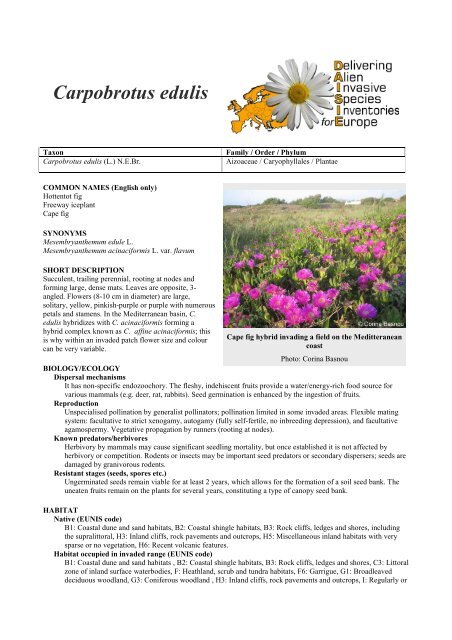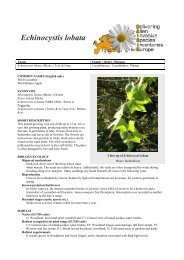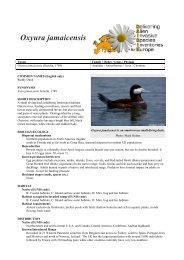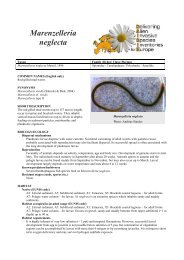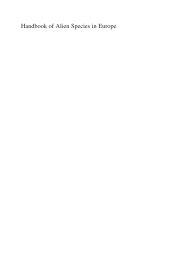Carpobrotus edulis
Carpobrotus edulis
Carpobrotus edulis
Create successful ePaper yourself
Turn your PDF publications into a flip-book with our unique Google optimized e-Paper software.
<strong>Carpobrotus</strong> <strong>edulis</strong><br />
Taxon Family / Order / Phylum<br />
<strong>Carpobrotus</strong> <strong>edulis</strong> (L.) N.E.Br. Aizoaceae / Caryophyllales / Plantae<br />
COMMON NAMES (English only)<br />
Hottentot fig<br />
Freeway iceplant<br />
Cape fig<br />
SYNONYMS<br />
Mesembryanthemum edule L.<br />
Mesembryanthemum acinaciformis L. var. flavum<br />
SHORT DESCRIPTION<br />
Succulent, trailing perennial, rooting at nodes and<br />
forming large, dense mats. Leaves are opposite, 3angled.<br />
Flowers (8-10 cm in diameter) are large,<br />
solitary, yellow, pinkish-purple or purple with numerous<br />
petals and stamens. In the Mediterranean basin, C.<br />
<strong>edulis</strong> hybridizes with C. acinaciformis forming a<br />
hybrid complex known as C. affine acinaciformis; this<br />
is why within an invaded patch flower size and colour<br />
can be very variable.<br />
Cape fig hybrid invading a field on the Meditteranean<br />
coast<br />
Photo: Corina Basnou<br />
BIOLOGY/ECOLOGY<br />
Dispersal mechanisms<br />
It has non-specific endozoochory. The fleshy, indehiscent fruits provide a water/energy-rich food source for<br />
various mammals (e.g. deer, rat, rabbits). Seed germination is enhanced by the ingestion of fruits.<br />
Reproduction<br />
Unspecialised pollination by generalist pollinators; pollination limited in some invaded areas. Flexible mating<br />
system: facultative to strict xenogamy, autogamy (fully self-fertile, no inbreeding depression), and facultative<br />
agamospermy. Vegetative propagation by runners (rooting at nodes).<br />
Known predators/herbivores<br />
Herbivory by mammals may cause significant seedling mortality, but once established it is not affected by<br />
herbivory or competition. Rodents or insects may be important seed predators or secondary dispersers; seeds are<br />
damaged by granivorous rodents.<br />
Resistant stages (seeds, spores etc.)<br />
Ungerminated seeds remain viable for at least 2 years, which allows for the formation of a soil seed bank. The<br />
uneaten fruits remain on the plants for several years, constituting a type of canopy seed bank.<br />
HABITAT<br />
Native (EUNIS code)<br />
B1: Coastal dune and sand habitats, B2: Coastal shingle habitats, B3: Rock cliffs, ledges and shores, including<br />
the supralittoral, H3: Inland cliffs, rock pavements and outcrops, H5: Miscellaneous inland habitats with very<br />
sparse or no vegetation, H6: Recent volcanic features.<br />
Habitat occupied in invaded range (EUNIS code)<br />
B1: Coastal dune and sand habitats , B2: Coastal shingle habitats, B3: Rock cliffs, ledges and shores, C3: Littoral<br />
zone of inland surface waterbodies, F: Heathland, scrub and tundra habitats, F6: Garrigue, G1: Broadleaved<br />
deciduous woodland, G3: Coniferous woodland , H3: Inland cliffs, rock pavements and outcrops, I: Regularly or
ecently cultivated agricultural, horticultural and domestic habitats, J: Constructed, industrial and other artificial<br />
habitats.<br />
Habitat requirements<br />
Warm temperate to dry climate, sensitive to frost. Resistant to drought. Grows on well-drained acid to alkaline<br />
and also saline soils. Can grow on nutrient poor soils but it is N limited. It usually prefers to grow in the sun but<br />
can also develop well on the shade. It has inducible CAM metabolism when subjected to drought or salt-stress.<br />
DISTRIBUTION<br />
Native Range<br />
Cape Region of South Africa.<br />
Known Introduced Range<br />
Northern Europe (Great Britain, Ireland); Southwestern Europe (Balearic Islands, Gibraltar, Spain, Corsica,<br />
Sardinia, France); Southeastern Europe: (Italy, Sicily, Malta, Albania, Greece); West Temperate Asia: (Cyprus,<br />
Turkey, Lebanon-Syria, Israel-Jordan); Northern Africa (Algeria, Morocco, Libya, Macaronesia); Africa Middle<br />
Atlantic Ocean (St. Helena); Northern America (California, Florida); Southern America (Mexico, Chile,<br />
Argentina); South-Central Pacific (Pitcairn Is., French Polynesia); Australasia (Australia, New Zealand).<br />
Trend<br />
Apparently increasing due to increasing landscape use.<br />
MAP (European distribution)<br />
Known in country<br />
Legend<br />
Known in CGRS square<br />
Known in sea<br />
INTRODUCTION PATHWAY<br />
Intentionally introduced by man, mainly as an ornamental or landscaping plant, also as a medicinal plant. Widely used<br />
for erosion control on sandy habitats or loose rocks. Widely planted along highways, in open sites and gardens.<br />
IMPACT<br />
Ecosystem Impact<br />
It forms impenetrable mats and competes aggressively with native species, threatening rare and endangered<br />
species. Can modify soil properties by increasing soil N and organic C and by reducing soil pH. In dune habitats<br />
it prevents sand movement, hindering the natural processes of the disturbance regime. Hybrids are very vigorous<br />
and may lead to intensified invasion.
Health and Social Impact<br />
Unknown.<br />
Economic Impact<br />
Unknown.<br />
MANAGEMENT<br />
Prevention<br />
Avoid planting as ornamentals and dumping plant debris in the wild. Prescribed burnings (Tª > 100 °C) can<br />
reduce the seedbank.<br />
Mechanical<br />
Manual eradication (hand-pulling and buried stem removal) appears to be the most effective and cost-efficient<br />
method. Plant remains should be removed because they become an active part of regeneration. After removal,<br />
secondary invaders may take advantage the opened areas. For sand dunes, seeding native grasses has not been<br />
effective.<br />
Chemical<br />
Broad spectrum herbicides such as glyphosate kill this plant. Chlorflurenol has been used along roadways.<br />
Biological<br />
Intense herbivory may suppress seedling establishment and slow invasion of sand dunes and burned sites.<br />
REFERENCES<br />
Alvarez ME, Cushman JH (2002) Community-level consequences of a plant invasion: Effects on three habitats in<br />
coastal California. Ecol Appl 12:1434-1444<br />
Bourgeois K, Suehs CM, Vidal E, Medail F (2005) Invasional meltdown potential: Facilitation between introduced<br />
plants and mammals on French Mediterranean islands. Ecoscience 12:248-256<br />
D'Antonio CM (1990) Seed production and dispersal in the non-native, invasive succulent <strong>Carpobrotus</strong> <strong>edulis</strong><br />
(Aizoaceae) in coastal strand communities of Central California. J Appl Ecol 27:693-702<br />
OTHER REFERENCES<br />
D'Antonio CM (1993) Mechanisms controlling invasion of coastal plant-communities by the alien succulent<br />
<strong>Carpobrotus</strong> <strong>edulis</strong>. Ecology 74: 83-95<br />
D'Antonio CM, Mahall BE (1991) Root profiles and competition between the invasive, exotic perennial,<br />
<strong>Carpobrotus</strong> <strong>edulis</strong>, and 2 native shrub species in California coastal scrub. Am J Bot 78:885-894<br />
D'Antonio CM, Odion DC, Tyler CM (1993) Invasion of maritime chaparral by the introduced succulent<br />
<strong>Carpobrotus</strong> <strong>edulis</strong>. The roles of fire and herbivory. Oecologia 95:14-21<br />
Draper D, Rosselló-Graell A, Garcia C, Gomes CT, Sérgio C (2003) Application of GIS in plant conservation<br />
programmes in Portugal. Biol. Cons. 113:337–349<br />
Earnshaw MJ, Carver KA, Charlton WA (1987) Leaf anatomy, water relations and crassulacean acid metabolism in<br />
the chlorenchyma and colourless internal water-storage tissue of <strong>Carpobrotus</strong> <strong>edulis</strong> and Senecio ?mandraliscae.<br />
Planta 170:421 432<br />
Fraga P, Estaun I, Olives J, Da Cunha G, Alarcon A, Cots R, Juaneda J, Riudavets X (2006) Eradication of<br />
<strong>Carpobrotus</strong> (L.) N.E. Br. in Minorca. Available via IUCN Species Survival Commission<br />
http://www.iucn.org/places/medoffice/invasive_species/case_studies/eradication_carpobrotus_minorca.pdf.<br />
Cited 16 August 2006<br />
Gindre D, Pantel S (2006) Elaboration of a methodology for the control of <strong>Carpobrotus</strong> spp. On sand dunes of the<br />
Hérault department. In: Brunel S (ed) Invasive plants in Mediterranean type regions of the world, International<br />
Workshop, Mèze, France, May 2005. Environmental Encounters Series N o 59, Council of Europe Publishing, p<br />
324<br />
Global Invasive Species Database. Available via IUCN Species Survival Commission.<br />
http://www.issg.org/database. Cited 20 Oct 2006<br />
Kim A (2002) Determining an Effective Buffer Against Reinvasion of Restored Sand Dunes. In: Latto J, Orr M<br />
(eds) Studies of Ecological Interconnections. Justin Remais and Manish Desai University of California,<br />
Berkeley, p 12<br />
Malan C, Notten A (2006) <strong>Carpobrotus</strong> <strong>edulis</strong>(L.) L.Bolus. Available via S A National Biodiversity Institute -<br />
Kirstenbosch. http://www.plantzafrica.com/plantcd/carpobed.htm. Cited 20 Oct 2006<br />
Moragues E, Traveset A, Valladares F (2006) Good performance in both sun and shade habitats leads to the<br />
spreading of invasive <strong>Carpobrotus</strong> spp. in Mediterranean ecosystems. In: Brunel S (ed) Invasive plants in
Mediterranean type regions of the world, International Workshop, Mèze, France, May 2005. Environmental<br />
Encounters Series N o 59, Council of Europe Publishing, p 325<br />
Palmer M, Linde M, Pons GX (2004) Correlational patterns between invertebrate species composition and the<br />
presence of an invasive plant. Acta Oecol 26: 219–226<br />
Rice P (2005) Fire as a tool for controlling nonnative invasive plants. Available via Bozeman MT: Center for<br />
Invasive Plant Management. www.weedcenter.org/management/tools.htm#burning . Cited 20 Oct 2006<br />
Schierenbeck KA, Symonds VV, Gallagher KG, Kelly G, Bell J (2005) Genetic variation and phylogeographic<br />
analyses of two species of <strong>Carpobrotus</strong> and their hybrids in California. Mol Ecol 14:539-547<br />
Suehs CM, Affre L, Medail F (2004) Invasion dynamics of two alien <strong>Carpobrotus</strong> (Aizoaceae) taxa on a<br />
Mediterranean island: II. Reproductive strategies. Heredity 92:550-556<br />
Suehs CM, Affre L, Médail F (2005) Unexpected insularity effects in invasive plant mating systems: the case of<br />
<strong>Carpobrotus</strong> (Aizoaceae) taxa in the Mediterranean Basin. Biol J Linn Soc 85:65-79<br />
Suehs CM, Charpentier S, Affre L, Médail F (2006) The evolutionary potential of invasive <strong>Carpobrotus</strong> (Aizoaceae)<br />
taxa: are pollen-mediated gene flow potential and hybrid vigor levels connected? Evol Ecol 20:447–463<br />
van der Watt E, Pretorius JC (2001) Purification and identification of active antibacterial components in<br />
<strong>Carpobrotus</strong> <strong>edulis</strong> L. J Ethnopharmacol 76:87-91<br />
Vilà M, D'Antonio CM (1998) Fitness of invasive <strong>Carpobrotus</strong> (Aizoaceae) hybrids in coastal California.<br />
Ecoscience 5:191-199<br />
Vilà M, D'Antonio CM (1998) Fruit choice and seed dispersal of invasive vs. noninvasive <strong>Carpobrotus</strong> (Aizoaceae)<br />
in coastal California. Ecology 79:1053-1060<br />
Vilà M, D'Antonio CM (1998) Hybrid vigor for clonal growth in <strong>Carpobrotus</strong> (Aizoaceae) in coastal California.<br />
Ecol Appl 8:1196-1205<br />
Vilà M, Weber E, D'Antonio CM (1998) Flowering and mating system in hybridizing <strong>Carpobrotus</strong> (Aizoaceae) in<br />
coastal California. Can J Bot 76:1165-1169<br />
Vilà M., M. Tessier, C. M. Suehs, G. Brundu, L. Carta, A. Galanidis, P. Lambdon, M. Manca, F. Médail, E.<br />
Moragues, A. Traveset, A. Y. Troumbis y P. E. Hulme. 2006. Regional assessment of the impacts of plant<br />
invaders on vegetation structure and soil properties of Mediterranean islands. Journal of Biogeography 33: 853-<br />
861<br />
Weber E, D'Antonio CM (1999) germination and growth responses of hybridizing <strong>Carpobrotus</strong> species (Aizoaceae)<br />
from coastal California to soil salinity. Am J Bot 86:1257–1263.<br />
Weber E, D'Antonio CM (1999) Phenotypic plasticity in hybridizing <strong>Carpobrotus</strong> spp. (Aizoaceae) from coastal<br />
California and its role in plant invasion. Can J Bot 77:1411-1418<br />
Author: Pinelopi Delipetrou<br />
Date Last Modified: November 21 th , 2006


